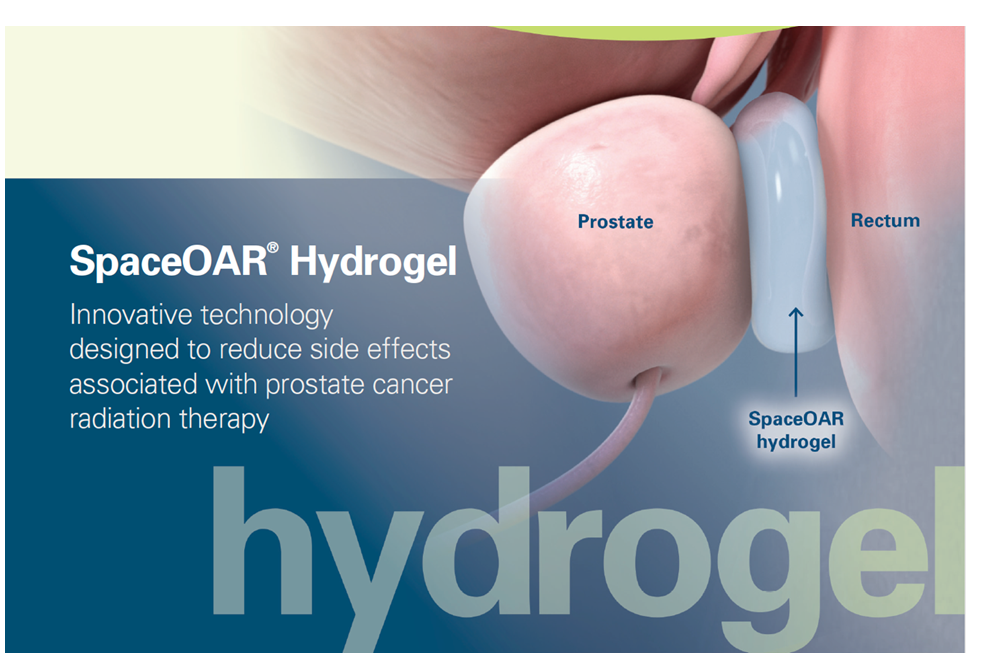Why should I have SpaceOARTM Hydrogel?
When treating prostate cancer patients with radiation therapy, the goal is to kill the cancer cells while avoiding damage to surrounding healthy tissue. The prostate is next to the rectum and naturally separated by a small space. Due to the proximity, prostate radiation therapy can unintentionally cause damage to the rectum, which can lead to issues with bowel function. The “OAR” in SpaceOAR stands for “organ at risk,” and with radiation therapy to the prostate, this organ is the rectum.
How will SpaceOAR Hydrogel help me?
By acting as a spacer, the hydrogel temporarily moves the rectum a half inch (1.3 cm) away from the prostate.By separating the prostate from the rectum, SpaceOAR Hydrogel reduces the radiation dose delivered to the rectum and may eliminate or decrease damage.
What is it made of?
SpaceOAR Hydrogel is made up of two liquids that when combined form a soft gel material that is mostly made of water. The material that the SpaceOAR Hydrogel is made from has been used in other implants such as surgical sealants used in the eye, brainand spine.
Where is the procedure done and how long does it take?
SpaceOAR Hydrogel can be implanted as an outpatient procedure in a hospital, surgery center, outpatient clinic or doctor’s office prior to the start of radiation treatment. It is typically not a lengthy procedure.
In what type of prostate cancer radiation treatment can SpaceOAR Hydrogel be used?
SpaceOAR Hydrogel can be used in all typesof radiation therapy. Here are the four most common types:
- External radiation (or external beam radiation therapy – EBRT) uses a machine that directs high-energy rays (or photons) from outside of the body into the tumor. Most patients get external radiation therapy over many weeks, during outpatient visits to a hospital or treatment center.
- Internal radiation, also called brachytherapy, involves putting a radioactive source inside the body into or near the tumor.
- Stereotactic body radiation therapy (SBRT) uses advanced imaging techniques to deliver extremely precise, very intense doses of radiation to the prostate (usually in up to five treatments over a period of days).
- Proton beam therapy uses proton particles in lieu of x-rays or photons.
How is SpaceOARTM Hydrogel implanted (put into place)?
The SpaceOAR Hydrogel is injected as liquid through a small needle inserted between the rectum and the prostate. Your doctor will use ultrasound imaging to ensure correct placement.
What do I need to do to get ready before the procedure?
Your doctor will give you instructions on how to prepare for the procedure and information about any anesthesia you will receive.
Will I be awake or asleep during the procedure?
SpaceOAR Hydrogel can be implanted under local, regional or general anesthesia. You should discuss with your doctor which type of anesthesia will work bestfor you.
Will I feel any discomfort or pain during or after the procedure?
Your doctor will use a local, regional or general anesthesia and the injection site will be numbed, so you may feel a pinprick or pressure but should not feel any discomfort. Following the implantation, you may experience some temporary discomfort at the injection site. SpaceOAR Hydrogel patients typically report no prolonged discomfort from the implanted gel.
How soon after the procedure can I return to my normal activities?
You should be able to go back to your normal activities soon. Check with your doctor about anything you should avoid after the procedure and during your radiation treatments.
How long will SpaceOAR Hydrogel remain in my body?
SpaceOAR Hydrogel stays in place, separating your prostate and rectum, for about 3 months. After about 6 months, the hydrogel is naturally absorbed into the body and removed in your urine.
What are the risks associated with SpaceOAR Hydrogel?
As with any medical treatment, there are some risks involved with the use of SpaceOAR Hydrogel. Potential complications associated with SpaceOAR Hydrogel include, but are not limited to: pain associated with SpaceOAR Hydrogel injection; pain or discomfort associated with SpaceOAR Hydrogel; needle penetration of the bladder, prostate, rectal wall, rectum or urethra; injection of SpaceOAR Hydrogel into the bladder, prostate, rectal wall, rectum or urethra; local inflammatory reactions; infection; injection of air,
fluid or SpaceOAR Hydrogel intravascularly; urinary retention; rectal mucosal damage, ulcers, necrosis; bleeding; constipation; and rectal urgency.
Has SpaceOAR Hydrogel been clinically tested?
SpaceOAR Hydrogel has been evaluated in many clinical studies and shown to be effective in reducing radiation to organs at risk.
- In the U.S., 222 prostate cancer patients participatedin a multi-center, randomized, patient-blinded clinical study. Study results showed that the hydrogel was safe and effective. The average SpaceOAR Hydrogel study patient gained 1⁄2 inch (1.3 cm) of space between the prostate and rectum, and had significant reduction in radiation dose to the rectum resulting in significantly fewer rectal side effects.
-
Follow-up study
- Three years after treatment, patients from the study were asked to report on their quality of life for bowel, urinary and sexual functions. These patient-reported outcomes showed that SpaceOAR Hydrogel patients experienced significantly fewer long-term rectal side effects, were more likely to maintain sexual function, and showed significantly lower decline in patient- reported urinary and bowel quality of life.





